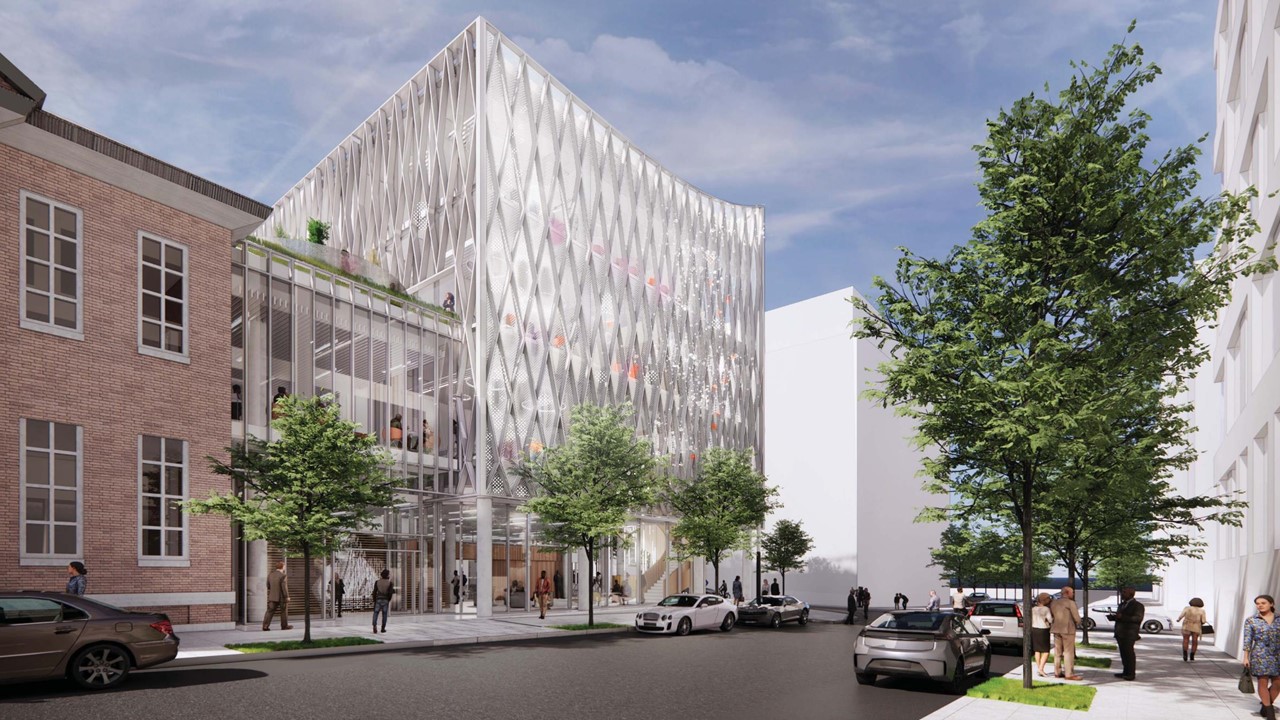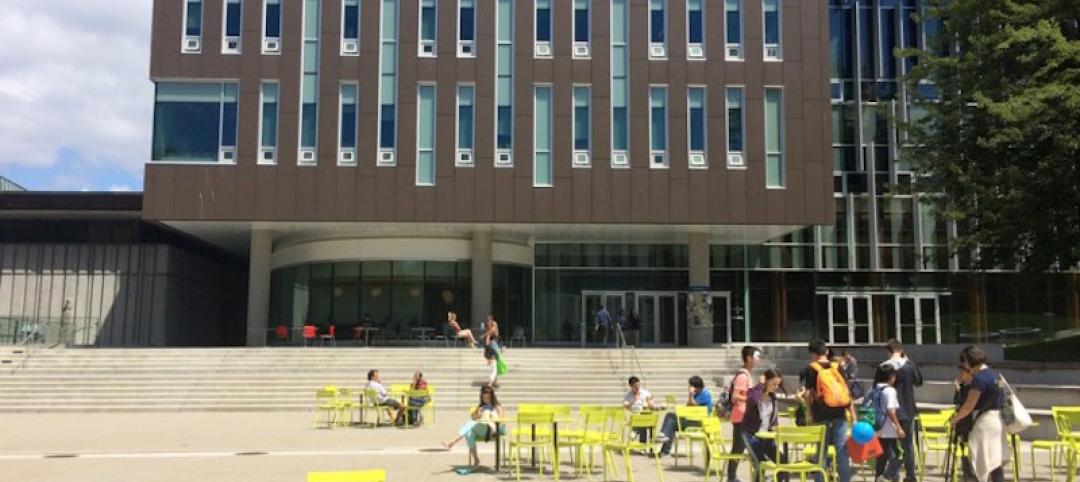In November, Johns Hopkins University and Johns Hopkins Medicine shared the initial design plans for a campus building project named in honor of Henrietta Lacks, the Baltimore County woman whose cells have advanced medicine around the world. Diagnosed with cervical cancer, Lacks, an African-American mother of five, sought treatment at the Johns Hopkins Hospital in the early 1950s. Named HeLa cells, the cell line that began with Lacks has contributed to numerous medical breakthroughs.
In East Baltimore, the roughly 34,000-sf building will adjoin Deering Hall, which houses the Berman Institute of Bioethics. The new building will support multidisciplinary and complementary programs of the Berman Institute and the Johns Hopkins University School of Medicine, as well as other university divisions. It will provide flexible program and classroom space for education and research, as well as meeting space for community use.
The building is meant to inspire efforts to address inequities in biomedical research and healthcare, according to Jeffrey Kahn of the Berman Institute of Bioethics.
The project aims to direct 30% of addressable spend to minority-owned and women-owned businesses and disadvantaged business enterprises, and 20% to local business enterprises. The building is designed and managed by local and/or minority-owned businesses. Vines Architecture, an African American-owned firm based in Raleigh, N.C., completed a yearlong feasibility study for the new building and has been selected as the project’s design architect of record. Turner Construction and Baltimore construction firm Mahogany lead the pre-construction services and provide construction management.
“The design reflects not only [my grandmother’s] strong and beautiful spirit but the important role she plays in the history, and future, of East Baltimore,” Jeri Lacks Whye, granddaughter of Henrietta Lacks and member of the Henrietta Lacks Building Advisory Committee, said in a statement.
Construction is scheduled to start in early 2023, with completion planned for 2025.
Here is the office statement from Johns Hopkins Medicine:
Johns Hopkins University and Johns Hopkins Medicine today presented the initial design plans for the on-campus building project named in honor of Henrietta Lacks, the Baltimore County woman whose cells have advanced medicine around the world, during an Urban Design and Architecture Advisory Panel meeting for Baltimore City Planning. This marks an important milestone in the building project, for which design work will continue through the end of the year.
“The architectural design of the building to be named for Henrietta Lacks reflects Johns Hopkins’ commitment to proudly honor and celebrate Mrs. Lacks’ extraordinary legacy on our campus,” says Ronald Daniels, president of Johns Hopkins University. “We are excited to share these plans with the city’s design and architecture advisory panel, and we look forward to continuing to work closely with the Baltimore community and the family of Henrietta Lacks as this important project moves forward.”
The new, approximately 34,000 square foot building in East Baltimore will adjoin Deering Hall, a historic structure that is home to the Berman Institute of Bioethics. Located at the corner of Ashland and Rutland avenues, in the heart of Baltimore’s Eager Park community, the building will support multidisciplinary and complementary programs of the Berman Institute and the Johns Hopkins University School of Medicine, and other university divisions, and will include flexible program and classroom space to support education and research. Meeting space will also be made available for community use.
"It is exciting to know what the building named in honor of my grandmother, Henrietta Lacks, will look like from the outside, captivating her legacy. I’m happy to see it presented to the Baltimore community,” says Jeri Lacks Whye, granddaughter of Henrietta Lacks and member of the Henrietta Lacks Building Advisory Committee. “The design reflects not only her strong and beautiful spirit but her important role she plays in the history, and future, of East Baltimore.”
“This important building will significantly expand our capacity for teaching, scholarship and community-building, inspiring efforts to address inequities in biomedical research and health care that are an additional tribute to its remarkable namesake,” says Jeffrey Kahn, Ph.D., M.P.H., Andreas C. Dracopoulos director of the Berman Institute of Bioethics.
Construction is planned to start next year. Johns Hopkins also announced that the building will be completed in 2025, with an opening celebration to be planned.
“The expression of this building is unique to its surroundings, as Henrietta Lacks was a unique African American human being in this world. Our team has worked to design a building that fits within the urban context but has a special identity that we hope people believe warrants carrying the name of Henrietta Lacks,” says Victor Vines, president and Robert Thomas, director of design of Vines Architecture. “As we continue progress on the design, we believe that this building will remain a critical way to share the story of Henrietta Lacks for generations to come.”
For more information about the project, visit hopkinsmedicine.org/henriettalacks/updates.html.
About Henrietta Lacks and the HeLa Cells
Henrietta Lacks was a 31-year-old African American mother of five from Baltimore County who sought treatment at The Johns Hopkins Hospital in the early 1950s. Doctors diagnosed Mrs. Lacks with cervical cancer, and as medical records show, she received care that included the best medical treatment available at the time for this terrible disease. Unfortunately, treatment was unsuccessful, and Mrs. Lacks passed away in October 1951.
A sample of Mrs. Lacks’ cancer cells was retrieved during a biopsy and sent to cancer researcher Dr. George Gey's nearby tissue lab, where he had been collecting cells from patients who came to Johns Hopkins Hospital with cervical cancer. He discovered these cells were unlike any of the others he had seen: Where other cells would die, Mrs. Lacks' cells survived, and the number of cells would double every 20 to 24 hours. Soon after that, he began sharing the cells, at no cost, with researchers around the world. Deemed “HeLa” cells, the cell line that began from the biopsy from Mrs. Lacks proved to be remarkably durable and prolific, and while many additional cell lines are in use today, HeLa cells have had a unique contribution to untold medical breakthroughs over the decades since their discovery.
In 2013, Johns Hopkins worked with members of the Lacks family and the National Institutes of Health (NIH) to help craft an agreement that requires scientists to receive permission to use Henrietta Lacks’ genetic blueprint in NIH-funded research.
The NIH committee tasked with overseeing the use of HeLa cells now includes two members of the Lacks family. The biomedical research community has also made significant strides in updating research practices for the donation and use of tissue from patients, in part thanks to the lessons learned from Henrietta Lacks’ story.
To learn more about Henrietta Lacks and the wide-ranging impact of HeLa cells on medical research, please visit hopkinsmedicine.org/henriettalacks.
Related Stories
University Buildings | Oct 25, 2016
Columbia University dedicates its new campus with great fanfare
Transparency to the surrounding community played a big role in the campus’s design.
School Construction | Oct 23, 2016
As construction rebounds, education sector spending flattens
Post-recession slump suggests a settling in at a “normal” level similar to the mid aughts.
University Buildings | Oct 19, 2016
UC Merced to nearly double its size by 2020
Its growth strategy includes adding 1.2 million sf of space for teaching, housing, and research.
University Buildings | Oct 12, 2016
The new Hancher Auditorium opens on University of Iowa campus
The building replaces the previous Hancher, which was irreparably damaged in the 2008 flood.
University Buildings | Oct 11, 2016
The University of Iowa gets a new Visual Arts Building
The building was a collaborative effort between BNIM and Steven Holl Architects and marks the sixth facility the two firms have worked together on
Sponsored | University Buildings | Oct 3, 2016
Enhancing university life: The smart shower bead
Residential spaces that need to meet high traffic demands while accommodating an ever-changing populace creates a unique set of obstacles for any educational institution’s housing.
Sponsored | University Buildings | Sep 29, 2016
UWM’s Kenwood Interdisciplinary Research Complex: The most distinctive building on campus
The largest building on campus, it was designed by Flad Architects to comply with LEED Gold Certification standards and to meet a wide range of current and future academic needs.
University Buildings | Sep 12, 2016
The University of Chicago’s newest residence halls are designed to be more like home
Abundant common spaces give students more chances to interact.
University Buildings | Aug 17, 2016
Supporting communities of motivated learners: reflections on SCUP-51
The two themes that were consistently woven into different topics were institutional transformation and connection with students.
University Buildings | Aug 16, 2016
New images of Rice University’s Moody Center for the Arts revealed by Michael Maltzan Architecture
The arts center will foster creativity for making and presenting works across all disciplines
















